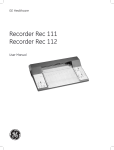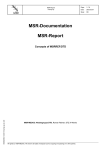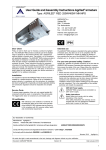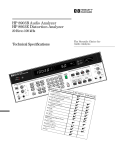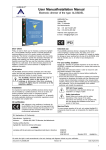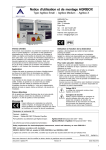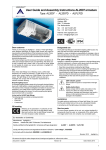Download Manual BD12E.ai
Transcript
INSTRUCTION MANUAL FLATBEDRECORDER 1 channel Model BD 11E 2 channel Model BD 12E Instruction manual B D 1 1E / BD 1 2E IMPORTANT USER INFORMATION Reading this entire manual is recommended for a full understanding of this product. The exclamation mark within an equilateral triangle is intended to alert the user to the presence of important operating and maintenance instructions in the literature accompanying the instrument. Should you have any comments on this manual, we will be pleased to receive them. The producer reserves the right to make changes in the specifications without prior notice. WARRANTY AND LIABILITY The producer guarantees that the product delivered has been thoroughly tested to ensure that it meets its published specifications. The warranty included in the conditions of delivery is valid only if the product has been installed and used according to the instructions supplied by the producer. Modifications made by the customer or on customers request can affect the validity of the CE declaration. The producer shall in no event be liable for incidental or consequential damages, including without limitation, lost profits, loss of income, loss of business opportunities, loss of use and other related exposures, however caused, arising from the faulty and incorrect use of the product. COPYRIGHT 2004 All rights reserved. No part of this publication may be reproduced, stored in a retrieval system or transmitted in any form or by any means, without permission in written form from the producer. Van Renesse Supplies B.V. 1 Instruction manual B D 1 1E / BD 1 2E Konformitätsbescheinigung According to EC guideline 89/336/EEC 73/23/EEC Producer: Van Renesse Supplies B.V. Vlotlaan 350 2681 TV Monster Productname: Flatbedrecorder Type: BD11E and BD12E Conformity with the following standards: Imissions: EN 50082-1 IEC 1000-4-2 IEC 1000-4-3 IEC 1000-4-4 Groupstandard IEC 801-2 8 kV IEC 801-3 3 V/m IEC 801-4 1 kV Emissions: EN 50081-1 EN 55022 Groupstandard Safety standard: IEC 1010-1 2 Van Renesse Supplies B.V. Instruction manual B D 1 1E / BD 1 2E CONTENTS CHAPTER 1 1.1. 1.2. 1.3. 1.4. 1.5. CHAPTER 2 2.1 2.2 2.3 2.3.1 2.3.2 2.3.3 2.3.4 CHAPTER 3 3.1 3.2 3.2.1 3.2.2 3.2.3 3.2.4 3.2.4.1 3.2.4.2 3.2.5 KAPITEL 4 4.1 4.1.1 4.1.2 4.2 4.2.1 4.2.1.1 4.2.1.2 4.2.1.3 4.2.1.4 4.2.1.5 4.2.1.6 4.2.2 4.2.2.1 4.2.2.2 4.2.2.3 4.2.2.4 SAFETY 5 INTRODUCTION SAFETY PRECAUTIONS CAUTION AND WARNING STATEMENTS SYMBOLS IMPAIRED SAFETY-PROTECTION 5 5 5 5 5 GENERAL INFORMATION 7 INTRODUCTION PRINCIPLE OF OPERATION SPECIFICATIONS General specifications Servo system Chart drive system External available I/O 7 7 8 8 8 9 9 PREPARATIONS FOR USE 11 UNPACKING INSTALLATION Safety instructions for power connection Changing paper Changing pens Inspection of the main functions Chart drive Servo system Polarity selection 11 11 11 13 14 14 14 15 15 OPERATING INSTRUCTIONS 17 GENERAL Switching on and off Fuses OPERATOR PANEL FUNCTIONS Chart drive "Record on / off" "Chart speed", "mm / s // mm / min" "Int / ext" Paper transport "Home" and "set" "Grid" Servo system "Span" "Cal / var" "Zero” and "Zero adjust" Electrical pen up / down 17 17 17 17 17 17 17 18 18 18 18 18 19 19 19 19 Van Renesse Supplies B.V. 3 Instruction manual B D 1 1E / BD 1 2E CHAPTER 5 5.1 5.1.1 5.2 5.3 5.3.1 5.3.2 EXTERNAL FUNCTIONS 21 GENERAL RS232-C ONLY FOR BD 11E I/O CIRCUITRY SPECIFICATIONS SIGNAL EXPLANATION External chart drive control Servo marker 21 21 21 22 23 23 APPENDIXES APPENDIX A 25 OPERATOR PANEL FUNCTIONS 25 SERVO SYSTEM CHART DRIVE 25 26 APPENDIX B THERMO MODULES 27 APPENDIX C ATTENUATOR AND SHUNTS 29 APPENDIX D ACCESSORIES AND SPARES 31 A.1 A.2 4 Van Renesse Supplies B.V. Instruction manual B D 1 1E / BD 1 2E CHAPTER 1 SAFETY Read this page carefully before installation and use of the instrument. 1.1 INTRODUCTION The instrument described in this manual is designed to be used by properly trained personnel only. Adjustment, maintenance and repair of the exposed equipment shall be carried out only by qualified personnel, that is aware of the hazards involved. 1.2 SAFETY PRECAUTIONS For the correct and safe use of the instrument it is essential that both operating and servicing personnel follow generally accepted safety procedures in addition to the safety precautions specified in this manual. Specific warning and caution statements, where they apply, will be found throughout the manual. Where necessary, the warning and caution statements and/or symbols are marked on the apparatus. 1.3 1.4 CAUTION AND WARNING STATEMENTS CAUTION: Is used to indicate correct operating or maintenance procedures in order to prevent damage to or destruction of the equipment or other property. WARNING: Calls attention to a potential danger that requires correct procedures or practices in order to prevent personal injury. SYMBOLS Meaning: 1.5 To preserve the protection afforded by the instrument from damage the operator must refer to an explanation in the instruction manual. IMPAIRED SAFETY-PROTECTION Whenever it is likely that safe operation is impaired, the instrument must be made inoperative and secured against unintended operation. The appropriate servicing authority must then be informed. Equipment connected to this unit must comply with the relevant IEC, UL and CSA standards. To comply with the UL and CSA safety standards only fuses of the same type and rating may be used. Such as Wickmann type 19195 according to IEC 127, UL recognised 250 mA for 115V and 125 mA for 230 V Van Renesse Supplies B.V. 5 Instruction manual B D 1 1E / BD 1 2E 6 Van Renesse Supplies B.V. Instruction manual B D 1 1E / BD 1 2E CHAPTER 2 2.1 GENERAL INFORMATION INTRODUCTION The flatbed recorder is available in four different versions, with one or two channels and with or without electrical penlift and remote control. BD11E BD12E single channel recorder with electrical penlift and remote control dual channel recorder with electrical penlift and remote control The BD11E and BD12E recorder is a compact recorder meeting today’s technology. The recorder uses a null balancing potentiometric system. The two-channel recorder offers two completely independent and isolated servo systems. Both pens use the full-scale width (200 mm). Disposable fibre pens are used, avoiding the inconvenience of a bleeding ink system. Many combinations of measuring ranges and additional options are possible (see appendix C - E). 2.2 PRINCIPLE OF OPERATION The recorder transports the chart paper at a constant velocity, which may be as slow as 0.1 mm per minute or as fast as 20 mm per second. The positions of two independent pens represent the levels of the two corresponding inputs of which the time functions are drawn. The full scale input sensitivity range from 1 mV to 20 VDC. The recorder is equipped with one chart drive control panel and with two independent servo system control panels, one for each channel. A number of functions can be controlled by means of the operator panel, as well as by external signals. They comprehend chart drive control and for both channels pen up and down and servo markers. A complete description of these functions and the interface can be found in chapter 4. Due to the nature of the two-channel recorder, the pen of channel 1 is always 2.5 mm behind the pen of channel 2. Van Renesse Supplies B.V. 7 Instruction manual B D 1 1E / BD 1 2E 2.3 SPECIFICATIONS 2.3.1 General specifications Recording system Recording paper Pen Power Supply : : : : Safety Imission : : Emission : Earth leakage current Ambient temperarture range Storage temperature Relative humidity (operating) Relative humidity (storage) Housing material : : : : : : Colour Weight Dimensions : : : 2.3.2 Servo system Span settings : Pen travel Number of pens Pen response time Span accuray Non linearity Dead zone Input terminals Input impedance : : : : : : : : Input current Input configuration Maximum input voltage Zero adjustment Zero : : : : : Zero drift Common mode rejection Mains frequency : : : Variable range setting : 8 potentiometric servo balance system roll chart (25 m) disposable fiber tip cartridges 93.5 - 132 V / 187 - 264 V, 50/60 Hz (voltage selector) max. consumption 30 VA (1 ch), 40 VA (2 ch) Certified in accordance with cUL 3101-1 and IEC 1010-1 EN 50082-1 Groupstandard IEC 1000-4-2 IEC 801-2 8 kV IEC 1000-4-3 IEC 801-3 3 V/m IEC 1000-4-4 IEC 801-4 1 kV EN 50081-1 Groupstandard EN 55022 < 0.5 mA in accordance with IEC 601-1, class B -10 to +40 0C. -40 to +75 0C. 20 - 85%, non condensing 5 - 95% Bay Blend no. FR 110-00005 flammability rating according to UL 94 V-O white 3.5 kg, including roll of chart 380 x 290 x 90 mm (W x D x H) 1-2-5-10-20-50-100-200-500 mV 1-2-5-10-20 V 200 mm 1 or 2, factory installed < 0.2 s for 5 - 95% fsd (full scale deflection) < 0.3% full scale deflection < 0.3% full scale deflection < 0.2% full scale deflection 2 safety terminals according to VDE 0110 class A 1 MOhm for DC, 10 kOhm in series with 1.5 µF for AC less than 5 nA floating 42 VDC / 30 VAC (personal safety limits) -50 to +150% full scale selectable left-hand or right-hand side of the paper (default left-hand side) < 1 µV / °C 130 dB (DC and 50 Hz AC permissible peak to peak max. 5 times interference (not visible) 40 - 100% of selected span Van Renesse Supplies B.V. Instruction manual B D 1 1E / BD 1 2E Pen lift 2.3.3 electrical pen lift, channel 1 and 2 independent, plus remote control connection : : : : : : : : : : 0.1-0.2-0.5-1-2-5-10-20 mm / min. or mm / sek. 0.05 mm better than +/- 50 ppm > 1 µs TTL pulse input maximum frequency 8 kHz (option) 1 - 12000 selectable by chart speed setting chart roll according to DIN 16230 25 m 20 minutes at highest chart speed 4100 hours at lowest chart speed Chart drive system Speed setting Step size Inaccuracy time base Pulse width External drive External division factor Recording paper Paper length Paper life 2.3.4 : External available I/O funktions BD11E / BD12E (remote control is optional) The following functions are available at the15 pin sub D connector, which is located at the rear side of the recorder: Pen lift channel 1 Pen lift channel 2 Start of plot / major gridmark Go to major gridmark Servomarker channel 1 Servomarker channel 2 "home" Chart stop External chartdrive pulse input Ground Chapter 5 EXTERNAL FUNCTIONS gives more information on these functions and the effect of installing options. Van Renesse Supplies B.V. 9 Instruction manual B D 1 1E / BD 1 2E 10 Van Renesse Supplies B.V. Instruction manual B D 1 1E / BD 1 2E CHAPTER 3 3.1 PREPARATIONS FOR USE UNPACKING The recorder is packed in a specially developed shipping carton. If damage to this carton is evident, ask the carrier’s agent to be present when the instrument is unpacked. Inspect the instrument for mechanical damage, and if there is damage, contact your local supplier. Verify the presence of all standard accessories and check the carton before throwing it away, to see if nothing is left inside. Standard accessories for recorder model BD11E: 1 instruction manual 1 fibre pen blue (short) 1 paper chart roll 1 mains supply cord 2 sets of 2 fuses Standard accessories for recorder model BD12E: 1 instruction manual 1 fibre pen blue (short) for channel 1 1 fibre pen red (long) for channel 2 1 paper chart roll 1 mains supply cord 2 sets of 2 fuses For ordering accessories and spare parts see appendix E. 3.2 INSTALLATION 3.2.1 Safety instructions for power connection Before connecting the equipment to the mains, ensure that the protective mains earth is functioning correctly. Before any other connection is made, the instrument shall be connected to a protective earth conductor via the three-core mains cable. The mains plug should be inserted only into a socket outlet provided with a protective earth contact. The protective action should not be negated by use of an extension cord without protective conductor. WARNING : Any interruption of the protective conductor inside or outside the instrument, or disconnection of the protective earth terminal, is likely to make the instrument dangerous. Intentional interruption is prohibited. Adjust the recorder according to the available mains supply. As the voltage selector suggests, the recorder may be operated at 230 V or 115 V. The switch involved is located at the rear side of the recorder, but can only be seen in the absence of the paper roll. Taking away the paper roll reveals a small square hole through which both the selected voltage and the switch itself can be seen. With the use of a pointed object this switch can be moved to the left or to the right, whatever position is desired. The location of this switch is shown in figure 1. Van Renesse Supplies B.V. 11 Instruction manual B D 1 1E / BD 1 2E Before switching on the recorder, make sure that the required fuses are installed. Operating the recorder at 115 V requires 250 mA fuses, while an operation voltage of 230 V requires 125 mA fuses. The mains on / off switch is located on the left-hand side of the recorder. Make sure that only fuses of the required current rating and type are used for renewal. The use of repaired fuses, and/or the shortcircuiting of fuse holders, is prohibited. Fuses should only be renewed by a qualified person, who is aware of the hazards involved. NOTE: If the mains plug has to be adapted to the local situation, it should only be done by a qualified person. WARNING : The instrument shall be disconnected from all sources when a fuse is to be renewed, or when the instrument is to be adapted to a different mains voltage. Figure 1 Rear side of the recorder 12 Van Renesse Supplies B.V. Instruction manual B D 1 1E / BD 1 2E 3.2.2 Changing Paper First lift the plastic transparent ruler off the paper (see fig. 2), turn it all the way to the top of the recorder and leave it in that position. In order to do so easily, place the fingers of both hands on top of the recorder housing and with both thumbs apply a gentle force to the respective ends of the ruler pointing upward and a little backward, for which purpose the ruler is equipped with small ridges. Figure 2 shows the lifting of the ruler. Figure 2 Lifting of the ruler Then push the edge of the paper (with a fingernail for example) in order to loosen it from the sprocket wheels. After that, the remains of the paper roll together with the plastic shaft can be taken out of the back of the recorder. The paper roll can be lifted easily through a hole in the bottom of the recorder housing. Unpack a new roll of paper, insert the shaft in the roll and put the two in place. Make sure that the orientation of the paper roll is such as to have the printed grid on top during normal operation. Then take the edge of the paper and slide it through the horizontal slit. (The transparent ruler still remains in the upright position.) Pull the paper towards you far enough to judge whether it is parallel to the recorder housing or not. Of course it should be. Then, with your fingertips make the holes in the edge of the paper fit the sprocket wheels, first at the left side and then at the right side. This is because the holes in the left side guarantee exact paper positioning, while the oval holes at the right side only support vertical transport. When the paper is in the correct position, fitting both sprocket wheels, with one hand hold the paper in position and with the other hand lower the ruler. Then with both hands simultaneously apply a gentle force both at the left and right side of the ruler. A double click indicates the proper lowering of the ruler. Van Renesse Supplies B.V. 13 Instruction manual B D 1 1E / BD 1 2E 3.2.3 Changing Pens The recorder is shipped with one (BD11E) or two (BD12E) packages of felt pens, each package containing 1 pen. The blue pen, the short one, is used with channel 1. The other red pen, the long one, is used with channel 2. The best thing to do before changing pens is to switch off the recorder completely. The pen holding mechanisms may then be moved freely into such a position that taking out the used pen and replacing it with the new pen, can be done the easiest way. If it is not desirable to switch off the recorder (to retain the home position for example) in order to be able to change pens, you should proceed as follows. For both channels the pens must be lifted by putting the pen lift lever in the “up” position. When the optional electrical pen lift is installed the respective switches marked “Pen Up / Down” must be in the upward position. Then the channel inputs must be zeroed by putting both the "Zero" switches in the downward position. Both pens will then remain at the position, which was chosen to correspond to the zero of scale. The moving of the pens has stopped and they can be replaced. After that, put back both zero switches into the upright operating position. Finally lower both pens to resume recording. Following this procedure, the only thing you get is a small gap in your recording, the size of which of course depends on both the paper speed and your manual dexterity. The time scale of your recording, however, has not been disturbed at all. Before switching off the recorder make sure the pens are lifted to avoid ink stains on the chart. If you intend not to use the recorder for some time, it is advised to take out the pens and to put back the small caps, which protect the pens against drying up. 3.2.4 Inspection of the main functions When you have gone through all the preparations described above, the recorder is ready for a short test of the main functions, which are described in the next sections. Remember that no external signal source has been connected to the recorder yet. A detailed description of all of the functions can be found, in chapter 4 OPERATING INSTRUCTIONS. Before performing the test, each of the twoposition switches, which are on the control panel, must be put in the upward position. Also the pen lift is in the lifted position. 3.2.4.1 Chart drive Push the button, which is marked with a down arrow. After 0.5 second the paper must start moving slowly and after 2 seconds the paper must start moving faster. Then release this button and push the button marked “home” once. This should bring back the paper to the position where it was before you operated the arrow key. Try out the same with the other arrow key. Each time you press the key indicated “grid”; the paper should advance one unit (i.e. 10 mm). Now press the button indicated “record on / off”. The paper should start moving at a speed corresponding to the setting of the chart speed turning knob. The speed you get of course still is in mm per second, because you started with all push buttons in the upward position. 14 Van Renesse Supplies B.V. Instruction manual B D 1 1E / BD 1 2E 3.2.4.2 Servo system The testing described below can be performed separately for each of the two channels. The position of the "range" switch is of no importance, while performing these tests. By operating the knob named zero-“adjust”, the pen can be positioned anywhere on the paper. Normally when there is no input, the pen is on the left-hand side edge of the paper. The pens can be moved up and down by operating the pen lift lever, which is located on the right-hand side just next to the extreme right position of the pens. When the optional electric pen lift is installed, pen 1 and 2 can be set up and down independently. When this testing has been performed successfully, this means that the basic functions of your recorder are working properly. NOTE: 3.2.5 Die oben gegebene Beschreibung basiert auf der Annahme, dass sich der Polaritätsschalter in Stellung "links" befindet. Polarity selection If desired, the polarity of each of the channel inputs can be inverted independently. The selection is performed by setting the involved switches, which are located at the rear side of the recorder. The location of these switches is indicated in figure 1 in chapter 3 PREPARATIONS FOR USE. They can only be accessed after the paper roll has been taken out, as described in section 3.2.2 Changing paper. The factory default setting of these switches is “left”. If one of these switches is set to “right”, the corresponding channel will have it zero position at the right hand side. NOTE : Inverting the input polarity does not result in a displacement of the zero position but in a mirrored channel performance. Van Renesse Supplies B.V. 15 Instruction manual B D 1 1E / BD 1 2E 16 Van Renesse Supplies B.V. Instruction manual B D 1 1E / BD 1 2E CHAPTER 4 OPERATING INSTRUCTIONS 4.1 GENERAL 4.1.1 Switching on and off Switching on and off is done with the small black switch which is located at the left-hand side of the recorder. Once it is switched on, it immediately is ready for use. On power up the origin (home position) is set at the location the paper was at that moment. With the "set" button the origin can be defined at any desired position. 4.1.2 FUSES The only problem that you may run into and which is user solvable is that of a blown fuse. There are two fuses, which are located next to the power switch. It is easy to replace them because you can take them out with the aid of a screwdriver or even the tip of your finger. If you have to replace one of the fuses, make sure to replace it with one of the same type. When the recorder is operated at 230 V the fuses are of the 125 mA type. When operated at 115 V they are of the 250 mA type. (see note on page 6). 4.2 OPERATOR PANEL FUNCTIONS 4.2.1 Chart Drive 4.2.1.1 "Record on / off" The function of this switch is to start and stop paper transport. When "record" is in the "off" position, it interrupts both the internal chart speed pulses and the external pulses. This switch must be put in the "off" position in order to be able to operate any of the following functions: “Forward / Reverse” (Arrows), “Home”, “Grid” and “Set”. When “record” is in the “on” position pressing any of the keys corresponding to the mentioned functions, has no effect at all. 4.2.1.2 "Chart speed", "mm / s // mm / min" The velocity at which the paper is moving is controlled by a combination of two choices. One concerns the position of the switch named "chart speed". There are eight possible positions, ranging from 0.1 to 20 units. The second choice concerns the applied unit, which is either mm / s or mm / min. This combination gives you a lowest speed of 0.1 mm per minute at which the paper roll has an expected lifetime of 4100 hours and a highest speed of 20 mm per second, at which a new roll of paper gives up after 20 minutes. Van Renesse Supplies B.V. 17 Instruction manual B D 1 1E / BD 1 2E 4.2.1.3 "Int / ext" The position of this switch determines the source of the pulses which make the paper move. When it is in the “Internal” position an internal clock, which can be adjusted as described in the previous section, is in effect. When the switch is in the "ext" position the chart drive must be fed with pulses from an external source. This is explained in more detail in chapter 5. 4.2.1.4 Paper transport The buttons associated with this function are marked with two small black triangles (arrows). With these buttons the paper can be positioned very precisely underneath the pens. Each time that one of these buttons is pressed shorter than one second, the paper is moved over a distance of 0.05 mm in the corresponding direction. If the key is held down, however, after one second the paper will start moving at a speed of 2 mm / s. It will do so for the next five seconds. So it moves over a distance of 10 mm. If the button is still being held at the end of the sixth second, the paper will start moving at a speed of 20 mm / s. Using proper timing while operating, these paper transport keys make it possible to put the pens at any desired position very quickly. The paper can only be transported in this manner when the “Record” switch is in the “off” position. 4.2.1.5 "Home" and "set" These buttons can only be operated when the “record” switch is in the “off” position. Pressing the “Home” button will bring back the paper to the position where the origin is located. Origin is either the position during powering up or the position where the “set” button was last pressed. "set" is used for defining a new origin for "Home" and at the same time for the "Major grid mark" position. Be careful not to operate the "home"-button, if you are not certain about the location of the origin. If the origin lies within an area of the paper, which already has been torn off the recorder, the recorder of course will loose control of the paper. Seeking home takes place at a velocity of 20 mm / s. 4.2.1.6 "Grid" This function is activated by pressing “grid”, also in the record off mode. Each time it is pressed, the paper advances to the next major grid mark. The major grid mark lines are lines parallel to the paperruler with 1 cm intervals. When the origin has been set precisely on top of a grid mark, pressing the "grid" button will always bring the pen on top of the next grid mark. Paper transport takes place at a velocity of 20 mm / s for this function. 4.2.2 Servo system The BD12E is equipped with two fully independent servo systems. Each servo system has an operator panel for controlling its functions. The following explanation of these functions holds equally well for both channels. The signals that are to be recorded must be connected to the corresponding input terminals at the rear side of the recorder. The black terminals are the negative ones and the red terminals the positive ones. The maximum input voltage, which is allowed across the terminals for each of the channels, is 30 VAC or 42 VDC for personal safety. If a higher input voltage is used, this will not damage your recorder, but 18 Van Renesse Supplies B.V. Instruction manual B D 1 1E / BD 1 2E the input terminals cannot be touched safely any more. The maximum allowable voltage difference across any two terminals of different channels is 500 V. 4.2.2.1 "Span" The input span of each channel is selected with the rotating switch named "range". This switch has 14 positions. Turned counter-clockwise all the way, a span of 20 V is chosen. This means that an input voltage of 20 V will move the pen all the way from the left- hand edge to the right-hand edge of the paper. (Supposed, of course, that the zero-position was at the left side of the paper) When the range switch is turned fully clockwise, the span is 1 mV full scale. The whole range in between these spans is covered in 14 steps according to the sequence 1, 2, 5, and 10. The input spans have these calibrated values only when the "cal / var" switch is in the "cal" position. 4.2.2.2 "Cal / var" When this switch is in the "cal" position an input signal equal to the selected range will result in a fullscale deflection. It may, however, sometimes be desirable to have an input span, which lies in between the values that can be chosen with the range switch. In such a case, the "cal / var" switch must be put in the "var" position, after which the variable span can be set by turning a potentiometer (indicated with "var") with the aid of a small screwdriver. Example: Suppose a signal varying between 0 and 25 mV has to be recorded and one wants to use the fullscale width. 1. 2. 3. Select the 50 mV range. Put the “cal / var” switch in the “var” position. And adjust the potentiometer until the amplitude reaches 100 % of scale. Da der variable Messbereich Justierungen von 40% bis 100% des geeichten Messbereichs zuläßt, kann jeder gewünschte (nicht geeichte) Messbereich zwischen 0.4 mV und 20 V erreicht werden. 4.2.2.3 "Zero" and "Zero adjust" When the "Zero" switch is in the down position, the pen will remain at its zero location. This is the location of the pen in the absence of an input voltage. The location of this point can be shifted to the left or to the right by turning the small knob zero "adjust". This function allows relocation of the zero point anywhere between the left and right edge of the paper. After the zero location has been chosen, the recorder must be put back into operation again by pressing the "zero" once again, which brings the switch back in the upward position. If desired, the signal axis together with the location of its zero point can be mirrored with respect to the centre of the recorder. Please refer to section 3.2.5 polarity selection for more information. 4.2.2.4 Electrical pen up / down BD11E / BD12E When the optional electrical pen lift is built in the pens can be lifted independent. If the pen remains too long at the same position, ink-stains will form on the paper. To avoid this, the recorder automatically lifts the pen when there has been no paper movement for more than 30 seconds. This time interval is equal to the time between two chart speed pulses when the recorder is Van Renesse Supplies B.V. 19 Instruction manual B D 1 1E / BD 1 2E operating at the lowest possible speed (i.e. 0,1 mm per minute). This time-out is being accomplished by checking both the internal and external chart speed pulses. This includes checking the operation of the arrow keys on the operator panel. 20 Van Renesse Supplies B.V. Instruction manual B D 1 1E / BD 1 2E CHAPTER 5 5.1 EXTERNAL FUNCTIONS GENERAL Through the remote control cable, a number of functions of the BD11E / BD12E can be remotely controlled. The remote control uses a 15 pin sub D type connector, which is located at the rear side of the recorder. The location of this connector is as shown in figure 1 in chapter 3 PREPARATIONS FOR USE. Its pins carry the signals, which belong to the involved functions. Each of these signals is described in section 5.4 SIGNAL EXPLANATION. 5.1.1 RS232-C ONLY FOR BD11E Via the remote cable input information for one channel is available in digitised form. This information can be directly read by any computer with an RS232-C interface. Data is sent in a time-multiplexed form. After each step of the paper transport mechanism, a digitised value for channel 1 is transmitted. 5.2 I/O Circuitry specifications for remote control (optional) All incoming signals are received by input logic as shown in figure 3. Figure 3 Input Logic When no signal is applied (open input), the pull-up resistor of 10 kOhm keeps the Schmitt-trigger input at a logical 1. This corresponds to a non-active situation for the respective function. This is true for all functions in the default situation (i.e. the way your BD11E / BD12E was factory set and shipped) If the function has to be activated, a logical 0 (zero) must be applied. This can be done by either short circuiting the input to ground or by applying an active zero (TTL spec.). Van Renesse Supplies B.V. 21 Instruction manual B D 1 1E / BD 1 2E 5.3 SIGNAL EXPLANATION BD11E / BD12E Figure 4 shows the connector lay out of the 15-pin sub D connector. Below a list is given with the functions that are available when these options are installed. Figure 4 15-pin sub D connector lay out 1 2 3 4 6 7 8 10 12 14 15 - pen lift channel 1 pen lift channel 2 start of plot / major gridmark go to major gridmark servomarker channel 1 servomarker channel 2 "home" ground chart on / off external chartdrive pulse input ground x= o= += x x x x x x x o o o o o o o + + o only available in record on mode "0" active or contact closure only available when internal penlift is not active In order to suppress unwanted interference from external origin, all signal inputs, except ECP (External Chartdrive Pulse) and servomarker, are being filtered. Any pulse that is shorter than 40 ms is rejected. As a consequence these signals are always delayed for 40 ms. 22 Van Renesse Supplies B.V. Instruction manual B D 1 1E / BD 1 2E 5.3.1 External chart drive control When an external chart drive Pulse (ECP) is used for moving the paper under the pens, a so-called divisor is applicable. This is a number between 1 and 12.000, by which the number of received pulses is divided, before one step (i.e. 0.05 mm) is made. The value of this divisor depends on the position of both the two-state button “mm / min” or “mm / s” and the 8 position turning knob "chart speed". Switching from "mm / s" to "mm / min" increases the divisor with a factor 60 and turning "chart speed" from 20 towards 0.1 accounts for a factor 200. The combination of these two results in a maximum dividend of 60 x 200, which equals 12.000. Method to determine the externally controlled chart speed: S x F x 0.0025 = Externally Controlled Chart Speed (mm / s) S = Chart Speed Setting (must be in mm / s) F = External Pulse Generator Frequency NOTE : Divide by 60 to convert mm / min. to mm / s The maximum frequency at which External Chart Pulses may be sent to the BD11E / BD12E recorder is 8 kHz. (Pulse duration at least 1 µs). Since the maximum stepping rate, corresponding to a maximum chart speed of 20 mm / s and a step size of 0.05 mm, equals 400 Hz, this maximum ECP frequency can only be handled properly by the recorder, if a dividend value of at least 25 is applicable. The user is responsible for maintaining this lowest value. If the steppermotor of the chart drive receives stepping pulses at a frequency greater than 400 Hz, it will stop turning regularly. This special property of the BD11E / BD12E has been built in to meet the requirements needed for unusual laboratory applications. Under normal circumstances External Chart Pulses do not need to have such a high frequency. There is no maximum for the ECP pulse duration, but it is recommended to use pulses of at least 1 µs. As soon as the positive edge is received, the chart drive will make one step. This is only true when the dividend equals 1. When the dividend has a value of N, that step will not be made until the Nth positive edge has appeared. 5.3.2 Servo marker When one of the servo marker functions is activated, the corresponding pen moves 10 mm to the left, with respect to the position it had. It then continues drawing the applied signal, only the drawn curve is shifted 10 mm to the left. As soon as the function is deactivated, the pen moves back to the position that represents the channel input value. This is true if the "zero" position is at the left-hand side of the paper. If it is at the right-hand side of the paper, then the pen moves to the right, when the servo marker function is activated. Van Renesse Supplies B.V. 23 Instruction manual B D 1 1E / BD 1 2E 24 Van Renesse Supplies B.V. Instruction manual B D 1 1E / BD 1 2E APPENDIX A A.1 OPERATOR PANEL FUNCTIONS SERVO SYSTEM (one for each channel) Each of the functions is indicated with a letter, which corresponds to a location indicated in figure A.1 below. a) "range" : Rotary switch with 14 positions selects span settings, ranging from 1 mV to 20 V fsd (full-scale deflection). b) "cal / var" : 2-position push button selects between calibrated and user adjustable span. c) "var" : Potentiometer to set span range from 40 to 100% fsd. d) "zero" : 2-position push button switches one channel amplifier input to zero, used for zero adjustment of the pen. e) "zero adjust" : Potentiometer with thumb wheel, used to position the pen on the paper. Figure A.1 Locations of functions Van Renesse Supplies B.V. 25 Instruction manual B D 1 1E / BD 1 2E f) "pen up / down" h) "POC on / off" A.2 : 2-position push button, used to activate the optional electrical pen lift (pen 1 and pen 2 independent). : 2-position push button selects between Pen Offset Compensation on and off. *** This 2-position push button is without function as POC module is no longer available. *** CHART DRIVE (left hand side of recorder) i) "record on / off" : 2-position push button switches between: - "Record on"-mode: internal chart speed settings or external pulse input and remote control functions. - "Record off"-mode: keyboard control of chart drive; forward, reverse, home, zero set and go to major gridmark. j) "chart speed" : 8-position rotary switch for fixed chart speed settings. k) "mm / sec" or "mm / min" : 2-position push button switches selected chart speed unit from mm / sec. to mm / min. l) "int / ext" : 2-position push button, switches between keyboard selected chart speed and external chart pulse input (optional). m) forward : Push button, transports the paper forward with increasing speed. n) backward : Push button, transports the paper backward with increasing speed. o) "set" : Push button, sets start of plot and major grid mark position. p) "home" : Push button, moves paper to start of plot position (with pen up). q) "grid" : Push button, moves the paper (always forward) to the next major grid mark (lines with 10 mm distance). When on grid mark the paper moves one grid mark further. r) "power" : Green LED to indicate power on. NOTE 26 : Functions l, m, n, o and p are only available in record off mode. Van Renesse Supplies B.V. Instruction manual B D 1 1E / BD 1 2E APPENDIX B THERMO MODULES For the BD11E and BD12E three different temperature modules are available: - thermocouple, type J, with linearisation, temperature range from –50°C to +1200°C - thermoelement, Typ K, with linearisation, temperature range from –50°C to +600°C - Pt100 module, with linearisation, temperature range from –100°C to +850°C See appendix E for type numbers. Both J and K thermocouple modules are active temperature measuring units, providing linearisation and automatic cold junction compensation. Linearisation is according to IPST 68. The output voltage is 1 mV / ºC. So a selected range of 100 mV gives a full scale deflection of exactly 100ºC and a selected range of 500 mV gives a full scale deflection of exactly 500ºC. The Pt100 module is an active measuring unit, suitable for measurement with the use of an external Pt100 element based on DIN 43760. The linearisation is based on DIN 43760. The output voltage is 1 mV / ºC. All temperature modules are powered from a separate power supply (3...12 VDC adapter). Van Renesse Supplies B.V. 27 Instruction manual B D 1 1E / BD 1 2E 28 Van Renesse Supplies B.V. Instruction manual B D 1 1E / BD 1 2E APPENDIX C ATTENUATOR AND SHUNTS For measuring higher voltages and currents five different attenuators and shunts are available: Attenuators: 100x, maximum voltage 500 V 10x, maximum voltage 500V See appendix E for type numbers. These attenuators have completely shielded banana inputs and outputs, to guarantee maximum safety. Shunts: - 0 – 20 mA shunt (100 Ω) giving full scale (20 mA) with input range on 2 V. - 4 – 20 mA shunt (125 Ω) giving full scale (20 mA) with input range on 2 V (zero shifted). 0 – 16 A shunt (10 m Ω) giving full scale (10 A) with input range on 0.1 V. The shunts also have completely shielded banana inputs, to allow currents with a high voltage related respect to ground. Van Renesse Supplies B.V. 29 Instruction manual B D 1 1E / BD 1 2E 30 Van Renesse Supplies B.V. Instruction manual B D 1 1E / BD 1 2E APPENDIX D ACCESSORIES AND SPARES Mains cord USA Mains cord Europa Mains cord UK 2570-042 2570-041 3444-293 1 Set of 10 fuses 125 mA for 230 V 1 Set of 10 fuses 250 mA for 115 V 2655-154 2655-196 Instruction manual german Instruction manual english Service manual english 0350-301 0350-300 0350-350 Standard packing with 10 chart rolls linear graduation (zero left) 2643-918 Standard packing with 10 chart rolls linear graduation (zero right) 2643-962 Fibre pens (short) for the BD11E recorder and channel 1 of the BD12E recorder: 5 Fibre pens, blue 5 Fibre pen, black 5 Fibre pens, red 5 Fibre pens, green 2643-852 2643-908 2643-909 2643-910 Fibre pens (long) for channel 2 of BD12E recorder: 5 Fibre pens, red 5 Fibre pens, black 5 Fibre pens, blue 2643-853 2643-858 2643-854 1 safety banana plug, red 1 safety banana plug, black 1 remote control cable (1.5 m) 1 carrying case 2523-597 2523-598 2570-167 2067-033 Attenuator 100x, 1.500 V max. Attenuator 10x, 1.500V max. 0328-322 0328-324 Current shunt 0 – 20 mA Current shunt 4 – 20 mA Current shunt 0 – 16 A 0328-320 0328-321 3300-001 Temperature module, type J Temperature module, type K Temperature module, Pt100 0350-732 0350-731 0336-704 Van Renesse Supplies B.V. 31 Instruction manual B D 1 1E / BD 1 2E 32 Van Renesse Supplies B.V. Customer Support Our customer support remains at your disposal for any maintenance or repair, calibration, supplies and spares. The address is as follows: Germany and Austria Für Servicearbeiten und Kalibrierung, Verbrauchsmaterial und Ersatzteile steht Ihnen unsere Customer Support Abteilung unter folgender Adresse zur Verfügung: Notre service 'Support Clientèle' reste à votre entière disposition pour tout problème de maintenance, réparation ou d'étalonnage ainsi que pour les accessoires et pièces de rechange. Leur adresse est la suivante : Gengenbach Messtechnik e.K. Heinrich-Otto-Strasse 3 D-73262 Reichenbach / Fils T +49 7153 9258 0 F +49 7153 9258 160 E [email protected] WWW.FLACHBETTRECORDER.DE








































